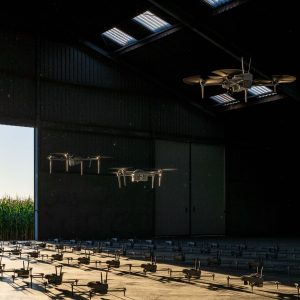Ohio Activists Rally Against Anduril’s $900 Million Drone Factory
On Sunday, over two dozen activists gathered at the Ohio Air National Guard Base located at Rickenbacker International Airport to protest the proposed Anduril Industries drone factory in Central Ohio. The demonstration was highlighted in a report by The Columbus Dispatch, marking a public backlash against the Southern California defense tech company’s ambitious $900 million “Arsenal 1” facility, which promises to create upwards of 4,000 jobs while raising significant ethical and environmental concerns.
The Arsenal 1 Vision: Hyperscaling Drone Production
Anduril’s Arsenal 1 facility, intended for a site near Rickenbacker International Airport in Pickaway County, aims to revolutionize military drone manufacturing. Encompassing 5 million square feet, the facility plans to initially produce the Fury unmanned aircraft system, recognized as a Group 5 autonomous drone featuring a wingspan of 36 feet and a range exceeding 621 miles, as per Anduril’s specifications. Future production may also include the Barracuda air-launched missile and the Roadrunner, a vertical takeoff and landing jet-powered interceptor spanning six feet. These innovations will incorporate artificial intelligence via Anduril’s Lattice OS platform for autonomous operations.
Anduril’s substantial investment, revealed in January 2025, is set to commence production by mid-2026, with Ohio contributing $70 million for essential infrastructure upgrades such as a new taxiway at Rickenbacker. This so-called “hyperscale” approach is designed to streamline production processes using AI and readily available materials, forming a cornerstone of Anduril’s drone technology ambitions.
Community Concerns: Jobs vs. Ethics
The demonstration, organized by Veterans for Peace and led by Darrin Broering, lasted around 90 minutes, featuring signs and chants voicing discontent. Broering acknowledged the allure of 4,000 new jobs yet advocated for alternative job creation pathways, suggesting, “Those jobs could be producing any number of things that would be more productive and less destructive.” This tension underscores a broader conflict between economic stimulation and ethical considerations regarding military manufacturing.
Concerns were also echoed by Pat Marida from the Ohio Nuclear Free Network, who warned of heightened militarization, potential environmental damage, and industry alteration, remarking that Anduril might “cement over Central Ohio.” Her grassroots strategy focuses on the $70 million state investment to halt the project, delving into larger discussions around ethics in Department of Defense contracting.
Technical Feasibility and Industry Context
The Fury drone is tailored for the U.S. Air Force’s Collaborative Combat Aircraft program, boasting a payload capability of 1,000 pounds and cooperation with manned aircraft, including the F-35. The Barracuda’s modular attributes lower costs of cruise missile adaptations, whereas the Roadrunner’s multifunctional capabilities reflect Anduril’s innovative leadership. Nevertheless, the prospect of achieving mass production by mid-2026 faces hurdles such as supply chain constraints and the complexities surrounding AI integration, often discussed across the drone industry.
In comparison to DJI’s dominance in civilian drone markets and Lockheed Martin’s defense heritage, Anduril’s agile startup approach presents a unique position. Their alignment with Pentagon objectives on autonomous systems challenges, however, the technical ambitions required for Arsenal 1’s vision.
Market and Regulatory Implications
Arsenal 1 propels Anduril into a more significant role within the U.S. defense sector, aided by a $14 billion valuation and links to prominent investors like Peter Thiel. Nestled 80 miles from Wright-Patterson Air Force Base, the facility enhances military collaboration prospects. However, the FAA’s regulatory oversight of military drones and environmental assessments, spotlighted by protests, complicates advancement. Ohio’s financial stake reveals confidence in the endeavor, yet public and regulatory scrutiny will challenge Anduril’s operation.
While Anduril’s Arsenal 1 could redefine drone manufacturing, yielding jobs and state-of-the-art systems to augment U.S. defense, the protests at Rickenbacker reflect a critical dichotomy: the potential for economic growth set against ethical costs. Achieving success will rely on adept technical execution alongside the navigation of local community sentiments and regulatory landscapes, possibly heralding a new era in drone production or revealing the limits of militarized technology’s social acceptance.
DroneXL’s Insight
The discourse surrounding Arsenal 1 resonates with a more extensive re-examination of drone technology. Anduril’s drive toward innovation fuels advancement, but resistance observed in Ohio stresses the necessity for a profound dialogue about the societal implications of autonomous weapon systems, a conversation imperative for the industry as a whole to engage and address.
Photo courtesy of Nathan Hart / The Columbus Dispatch
For further information, access the original article: Original Article













